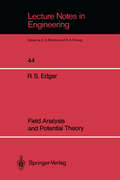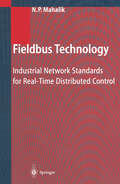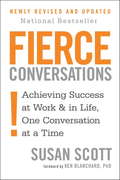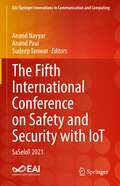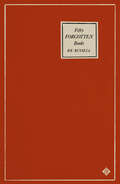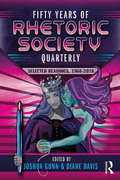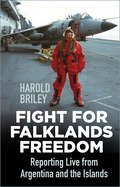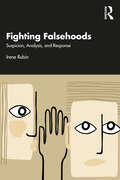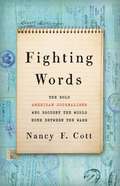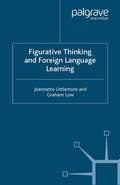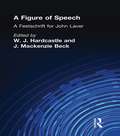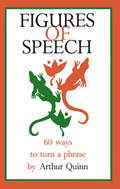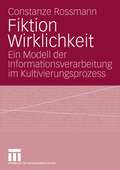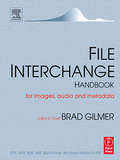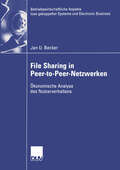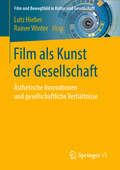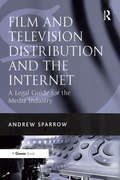- Table View
- List View
Field Analysis and Potential Theory (Lecture Notes in Engineering #44)
by Robert S. Edgar"Electromagnetic theory is a peculiar subject. The peculiarity resides not so much in the stratification - superposed layers of electrostatics. magnetostatics. steady currents and time-varying fields - as in the failure that has attended all attempts to weld these layers into a logical whole. The lowest layer. electrostatics. defines certain concepts. such as E. D, ~, in a way that is generally satisfactory only for the static case. Yet the attempt is made to force these specialised definitions into the higher strata, with ad hoc modifications when necessary. The student, in looking through his text books on electromagnetics, can find general definitions only with difficulty. if at all; and even the most advanced treatises fail to present a rigorously logical development of the subject". 1 So wrote Moon and Spencer some 30 years ago; and their criticism continues to be pertinent today. 2 More recently. a senior physicist of the National Bureau of Standards has expressed his concern in similar terms: "A logically consistent set of definitions of the electromagnetic field quantities is extremely difficult to find in the literature. Most text books either evade the problem or present definitions that are applicable only to special cases".
Fieldbus Technology: Industrial Network Standards for Real-Time Distributed Control
by Nitaigour P. MahalikFieldbus Technology (FT) is an enabling platform that is becoming the preferred choice for the next generation real-time automation and control solutions. This book incorporates a selection of research and development papers. Topics covered include: history and background, contemporary standards, underlying architecture, comparison between different Fieldbus systems, applications, latest innovations, new trends as well as issues such as compatibility, interoperability, and interchangeability.
Fierce Conversations: Achieving success in work and in life, one conversation at a time
by Susan ScottFierce Conversations is a way of conducting business. An attitude. A way of life. Communications expert Susan Scott maintains that a single conversation can change the trajectory of a career, marriage or life. Whether these are conversations with yourself, partner, colleagues, customers, family or friends, Fierce Conversations shows you how to have conversations that count. Scott reveals how to:*Overcome the barriers to meaningful conversations*Express who you are and what you believe*Confront tough issues with courage, confidence and sensitivity*Overcome fear to get to the heart of the problem*Inspire followers, attract believers and build visions that become reality*Bring about real change through talking*Encourage others to reveal their true opinionsPacked with exercises and questionnaires to help you have the best conversations possible, Fierce Conversations will revolutionise the way you communicate.
The Fifth Estate: The Power Shift of the Digital Age (OXFORD STUDIES DIGITAL POLITICS SERIES)
by William H. DuttonIn the eighteenth century, the printing press enabled the rise of an independent press--the Fourth Estate--that helped check the power of governments, business, and industry. In similar ways, the internet is forming a more independent collectivity of networked individuals, which William H. Dutton identifies as the Fifth Estate. Their network power is contributing to a more pluralist role of individuals in democratic political processes and society, which is not only shaping political accountability but nearly every sector of society. Yet a chorus of critics have dismissed the internet's more democratic potentials, demonizing social media and user-generated-content as simply sources of fake news and populism. So, is the internet a tool for democracy or anarchy? In The Fifth Estate, Dutton uses estate theory to illuminate the most important power shift of the digital age. He argues that this network power shift is not only enabling greater democratic accountability in politics and governance but is also empowering networked individuals in their everyday life and work, from checking facts to making civic-minded social interventions. By marshalling world leading research and case studies in a wide range of contexts, Dutton demonstrates that the internet and related digital media are enabling ordinary individuals to search, create, network, collaborate, and leak information in such independent and strategic ways that they enhance their informational and communicative power vis-à-vis other actors and institutions. Dutton also makes the case that internet policy interventions across the globe have increased censorship of users and introduced levels of surveillance that will challenge the vitality of the internet and the Fifth Estate, along with its more pluralist distribution of power. Ambitious and timely, Dutton provides an understanding of the Fifth Estate and its democratic potential so that networked individuals and institutions around the world can maintain and enhance its role in our digital age.
The Fifth Estate: The Power Shift of the Digital Age (OXFORD STUDIES DIGITAL POLITICS SERIES)
by William H. DuttonIn the eighteenth century, the printing press enabled the rise of an independent press--the Fourth Estate--that helped check the power of governments, business, and industry. In similar ways, the internet is forming a more independent collectivity of networked individuals, which William H. Dutton identifies as the Fifth Estate. Their network power is contributing to a more pluralist role of individuals in democratic political processes and society, which is not only shaping political accountability but nearly every sector of society. Yet a chorus of critics have dismissed the internet's more democratic potentials, demonizing social media and user-generated-content as simply sources of fake news and populism. So, is the internet a tool for democracy or anarchy? In The Fifth Estate, Dutton uses estate theory to illuminate the most important power shift of the digital age. He argues that this network power shift is not only enabling greater democratic accountability in politics and governance but is also empowering networked individuals in their everyday life and work, from checking facts to making civic-minded social interventions. By marshalling world leading research and case studies in a wide range of contexts, Dutton demonstrates that the internet and related digital media are enabling ordinary individuals to search, create, network, collaborate, and leak information in such independent and strategic ways that they enhance their informational and communicative power vis-à-vis other actors and institutions. Dutton also makes the case that internet policy interventions across the globe have increased censorship of users and introduced levels of surveillance that will challenge the vitality of the internet and the Fifth Estate, along with its more pluralist distribution of power. Ambitious and timely, Dutton provides an understanding of the Fifth Estate and its democratic potential so that networked individuals and institutions around the world can maintain and enhance its role in our digital age.
The Fifth International Conference on Safety and Security with IoT: SaSeIoT 2021 (EAI/Springer Innovations in Communication and Computing)
by Anand Nayyar Anand Paul Sudeep TanwarThis book presents the Fifth International Conference on Safety and Security with IoT (SaSeIoT 2021), which took place online. The conference aims to explore not only IoT and its related critical applications but also IoT towards Security and Safety. The conference solicits original and inspiring research contributions from experts, researchers, designers, and practitioners in academia, industry and related fields and provides a common platform to share knowledge, experience and best practices in various domains of IoT.
Fifty Forgotten Books
by R. B. RussellFifty Forgotten Books is a very special sort of book about books, by a great bibliophile and for book-lovers of all ages and levels of experience. Not quite literary criticism, not quite an autobiography, it is at once a guided tour through the dusty backrooms of long vanished used bookstores, a love letter to bookshops and bookselling, and a browser’s dream wish list of often overlooked and unloved novels, short story collections, poetry collections and works of nonfiction. In these pages, R. B. Russell, publisher of Tartarus Press, doesn’t only discuss the books of his life, but explains what they have meant to him over time, charting his progress as a writer and publisher for over thirty years, and a bibliophile for many more. Here is living proof of how literature, books, and book collecting can be an intrinsic part of one’s personal, professional and imaginative life, and as not only a solitary act, but a social one, resulting in treasured friendships, experiences, and loves one might never, otherwise, have enjoyed. Filled with a lively nostalgia for the era when finding strange new books meant pounding the pavement and not just searching booksellers’ websites, Fifty Forgotten Books is for anyone who wishes they could still browse the dusty bookshelves of their youth, and who can't wait to get back out into the world in quest of the next text liable to change their life.
Fifty Years of Rhetoric Society Quarterly: Selected Readings, 1968-2018
by Joshua Gunn Diane DavisFifty Years of Rhetoric Society Quarterly: Selected Readings, 1968-2018 celebrates the semicentennial of Rhetoric Society Quarterly, bringing together the most influential essays included in the journal over the past fifty years. Assessed by members of the Rhetoric Society of America, this collection provides advanced undergraduate and graduate students with a balanced perspective on rhetorical theory and practice from scholars in both communication studies and rhetoric and writing studies. The volume covers a range of themes, from the history of rhetorical studies, writing and speaking pedagogy, and feminism, to the work of Kenneth Burke, the rhetoric of science, and rhetorical agency.
Fifty Years of Rhetoric Society Quarterly: Selected Readings, 1968-2018
by Joshua Gunn Diane DavisFifty Years of Rhetoric Society Quarterly: Selected Readings, 1968-2018 celebrates the semicentennial of Rhetoric Society Quarterly, bringing together the most influential essays included in the journal over the past fifty years. Assessed by members of the Rhetoric Society of America, this collection provides advanced undergraduate and graduate students with a balanced perspective on rhetorical theory and practice from scholars in both communication studies and rhetoric and writing studies. The volume covers a range of themes, from the history of rhetorical studies, writing and speaking pedagogy, and feminism, to the work of Kenneth Burke, the rhetoric of science, and rhetorical agency.
Fight for Falklands Freedom: Reporting Live from Argentina and the Islands
by Harold BrileyThe world was told about the Falkland Islands invasion by radio, the news sweeping across the globe. Historian and war correspondent Sir Max Hastings, reporting from the Falkland Islands front-line, called it ‘the Radio Man’s War’ because it had a wider and quicker global reach. Harold Briley was the BBC ‘radio man’ in Buenos Aires. He broke the story on the BBC World Service and brought the Falklands saga to life. Previously the Falkland Islands were virtually unknown, but after Argentina invaded, and Britain reacted sending a Task Force 8,000 miles to liberate the Islanders, they made the front pages overnight. Harold Briley recounts the events of the time, from his eyewitness standpoint, as the man on the ground in Argentina. This book both recounts events and explains the attitude of the Falklands before and since the conflict, and the activities of the Argentine dictatorship intent on getting sovereignty.
Fighting Falsehoods: Suspicion, Analysis, and Response
by Irene RubinThis book offers the reader tools to recognize, analyze, and fight back against the fake news, misinformation, and disinformation that come at us from every corner. This volume: Uses real, lively examples to help readers detect fake news, false claims, suspicious information/data, biased reporting, and hate speech; Demonstrates through case studies where to look for information, what to look for, how to analyze the logic/illogic involved, and uncover the truth value of a story; Discusses fact-checking sites, what they examine, and their reliability; Provides examples and analyzes the components, purposes, and consequences of conspiracy theories; Illustrates the tricks of using numbers/data to mislead readers; Explains what to look for to help decide whether to believe the conclusions of stories based on surveys; Offers a range of concrete, effective responses to dangerous, exaggerated, distorted, and false narratives; Examines policy responses to fake news, disinformation, and misinformation across the world. A key manual to negotiate the information age, this book will be essential reading for students, scholars, and professionals of journalism and mass communication, public policy, politics, and the social sciences. It will also be an indispensable handbook for the lay reader.
Fighting Falsehoods: Suspicion, Analysis, and Response
by Irene RubinThis book offers the reader tools to recognize, analyze, and fight back against the fake news, misinformation, and disinformation that come at us from every corner. This volume: Uses real, lively examples to help readers detect fake news, false claims, suspicious information/data, biased reporting, and hate speech; Demonstrates through case studies where to look for information, what to look for, how to analyze the logic/illogic involved, and uncover the truth value of a story; Discusses fact-checking sites, what they examine, and their reliability; Provides examples and analyzes the components, purposes, and consequences of conspiracy theories; Illustrates the tricks of using numbers/data to mislead readers; Explains what to look for to help decide whether to believe the conclusions of stories based on surveys; Offers a range of concrete, effective responses to dangerous, exaggerated, distorted, and false narratives; Examines policy responses to fake news, disinformation, and misinformation across the world. A key manual to negotiate the information age, this book will be essential reading for students, scholars, and professionals of journalism and mass communication, public policy, politics, and the social sciences. It will also be an indispensable handbook for the lay reader.
Fighting Words: The Bold American Journalists Who Brought the World Home Between the Wars
by Nancy F. CottFrom a Harvard historian, this riveting portrait of four trailblazing American journalists highlights the power of the press in the interwar period. In the fragile peace following the Great War, a surprising number of restless young Americans abandoned their homes and set out impulsively to see the changing world. In Fighting Words, Nancy F. Cott follows four who pursued global news -- from contested Palestine to revolutionary China, from Stalin's Moscow to Hitler's Berlin. As foreign correspondents, they became players in international politics and shaped Americans' awareness of critical interwar crises, the spreading menace of European fascism, and the likelihood of a new war -- while living romantic and sexual lives as modern and as hazardous as their journalism. An indelible portrayal of a tumultuous era with resonance for our own, Fighting Words is essential reading on the power of the press and the growth of an American sense of international responsibility.
Figurative Thinking and Foreign Language Learning
by J. Littlemore Graham D. LowMany vocabulary items that foreign language learners encounter involve figurative extensions of meaning. To understand figurative speech, learners often need to employ figurative thinking. This book examines figurative thinking, considers its contribution to language ability, and explores the implications for language teaching and learning.
A Figure of Speech: A Festschrift for John Laver
by W. J. Hardcastle J. Mackenzie BeckThroughout the world, there are phoneticians who have been influenced by the teaching, research, and writings of John Laver. Many have worked with him personally, and most of the contributors to this book are people with whom he has had special links or whose involvement represents an appreciation of the breadth of Laver's interests. While the book is meant to be a tribute to John Laver, the topics have been chosen to provide an overview of some key issues in phonetics, with illuminating contributions from some of the most influential academics in the field. Contributing to this festschrift are William Hardcastle, Janet Mackenzie Beck, Peter Ladefoged, John J. Ohala, F. Gibbon, Anne Cutler, Mirjam Broersma, Helen Fraser, Peter F. MacNeilage, Barbara L. Davis, R. E. Asher, E. L. Keane, G. J. Docherty, P. Foulkes, Janet Fletcher, Catherine Watson, John Local, Ailbhe Ní Chasaide, Christer Gobl, John H. Esling, Jimmy G. Harris, and Francis Nolan.
A Figure of Speech: A Festschrift for John Laver
by William J. Hardcastle Janet Mackenzie BeckThroughout the world, there are phoneticians who have been influenced by the teaching, research, and writings of John Laver. Many have worked with him personally, and most of the contributors to this book are people with whom he has had special links or whose involvement represents an appreciation of the breadth of Laver's interests. While the book is meant to be a tribute to John Laver, the topics have been chosen to provide an overview of some key issues in phonetics, with illuminating contributions from some of the most influential academics in the field. Contributing to this festschrift are William Hardcastle, Janet Mackenzie Beck, Peter Ladefoged, John J. Ohala, F. Gibbon, Anne Cutler, Mirjam Broersma, Helen Fraser, Peter F. MacNeilage, Barbara L. Davis, R. E. Asher, E. L. Keane, G. J. Docherty, P. Foulkes, Janet Fletcher, Catherine Watson, John Local, Ailbhe Ní Chasaide, Christer Gobl, John H. Esling, Jimmy G. Harris, and Francis Nolan.
Figures of Speech: 60 Ways To Turn A Phrase
by Arthur QuinnWriting is not like chemical engineering. The figures of speech should not be learned the same way as the periodic table of elements. This is because figures of speech are not about hypothetical structures in things, but about real potentialities within language and within ourselves. The "figurings" of speech reveal the apparently limitless plastic
Figures of Speech: 60 Ways To Turn A Phrase
by Arthur QuinnWriting is not like chemical engineering. The figures of speech should not be learned the same way as the periodic table of elements. This is because figures of speech are not about hypothetical structures in things, but about real potentialities within language and within ourselves. The "figurings" of speech reveal the apparently limitless plastic
Fiktion Wirklichkeit: Ein Modell der Informationsverarbeitung im Kultivierungsprozess
by Constanze RossmannBeeinflusst das Fernsehen die Realitätswahrnehmung und Einstellungen der Zuschauer? Mit dieser Frage beschäftigt sich die Kultivierungsforschung nun seit gut dreißig Jahren. Wie es zur Entstehung von Kultivierungseffekten kommt, ist allerdings noch weitgehend unklar. Diese Analyse zeichnet die Ursprünge der Kultivierungsforschung nach und systematisiert bisherige Befunde zum Einfluss von Selektivität, von Rezeptionsmerkmalen und Determinanten der Urteilsbildung. Unter Einbeziehung psychologischer Erkenntnisse zur Informationsverarbeitung wird ein Prozessmodell entwickelt, das den Kultivierungsprozess zu erklären versucht und Anknüpfungspunkte für zukünftige Forschungsvorhaben liefert.
File Interchange Handbook: For professional images, audio and metadata
by Brad GilmerThe authoritative work on file formats for global film and television!The FILE INTERCHANGE HANDBOOK is a must-have reference for every film and video professional moving to computer based production and distribution. It is the only book that gives a complete scrutiny and breakdown of all file formats for the transfer of images, sound and metadata. Geared to a global audience, this text will get you the information that you need to learn this brand-new technology. Upcoming industry trends are mapped out alongside technology standards in this complete guide.Learn the purpose, functionality, and structure of each standard format with this single major reference on file interchange. This handbook is the one-stop resource you want for this essential technology.Table of contents:Intro--Brad Gilmer, Gilmer & Associates, Inc. 1. History / background--Hans Hoffman, EBU 2. Metadata dictionary--Oliver Morgan, Metaglue Corporation 3. Digital Picture eXchange (DPX)--Dave Bancroft, Thomson 4. General eXchange Format (GXF)--Bob Edge and Ray Baldock, Thomson Grass Valley 5. Material eXchange Format (MXF)--Jim Wilkinson, Sony, and Bruce Devlin, Snell & Wilcox, Ltd 6. Advanced Authoring Format (AAF)--Phil Tudor, BBC 7. Windows Media 9-Advanced System Format (ASF)--Nick Vicars-Harris, Microsoft Corporation 8. Apple QuickTime--George Towner, Apple Computer, Inc.Praise for the File Interchange Handbook:"Brad Gilmer has assembled a timely and valuable reference work covering the technical and structural aspects of file formats and wrappers used for processing program content. The book provides a clear, concise description of the file wrappers together with valuable background and applications information. It has been tailored for the practicing engineer and technical manager. Chapters on the SMPTE Metadata Dictionary and the Advanced Authoring Format are particularly relevant. This book is a valuable reference work for every practicing broadcast and teleproduction engineer, every Information Technology professional, and those in the telecommunications field who are actively involved in the manufacturing, management, transport or delivery of media and entertainment content." - Gavin Schutz, Chief Technology Officer, Ascent Media Group "I found this book to be an excellent up to date reference manual and a "must read" for anyone currently involved in the design and implementation of multimedia facilities. It helped me to gain a better understanding of issues that must be addressed as we transition our stations from traditional base band audio video environments to a file based IT infrastructures." - Ira Goldstone, VP chief technology officer Tribune Broadcasting "In the mid '90s, CNN and other broadcasters recognized the need for standardized file exchange of broadcast material. Our technology plans mapped a path to an integrated production environment that was based on video files instead of video streams. With these new systems, we wanted to ensure that we could continue to leverage the best technology for the various parts of our production systems while taking advantage of more efficient content access. This created a strong need for open, standardized methods of exchanging video files that would support a variety of compressions and Metadata. These protocols needed to handle everything from simple file exchange to complex authoring formats for content in active production. Because of these needs, CNN pushed the industry to create several of the formats discussed in detail in this book and provided active user requirements during their creation. Within the next year, CNN will have systems in place that use MXF for file exchange between our p
File Interchange Handbook: For professional images, audio and metadata
by Brad GilmerThe authoritative work on file formats for global film and television!The FILE INTERCHANGE HANDBOOK is a must-have reference for every film and video professional moving to computer based production and distribution. It is the only book that gives a complete scrutiny and breakdown of all file formats for the transfer of images, sound and metadata. Geared to a global audience, this text will get you the information that you need to learn this brand-new technology. Upcoming industry trends are mapped out alongside technology standards in this complete guide.Learn the purpose, functionality, and structure of each standard format with this single major reference on file interchange. This handbook is the one-stop resource you want for this essential technology.Table of contents:Intro--Brad Gilmer, Gilmer & Associates, Inc. 1. History / background--Hans Hoffman, EBU 2. Metadata dictionary--Oliver Morgan, Metaglue Corporation 3. Digital Picture eXchange (DPX)--Dave Bancroft, Thomson 4. General eXchange Format (GXF)--Bob Edge and Ray Baldock, Thomson Grass Valley 5. Material eXchange Format (MXF)--Jim Wilkinson, Sony, and Bruce Devlin, Snell & Wilcox, Ltd 6. Advanced Authoring Format (AAF)--Phil Tudor, BBC 7. Windows Media 9-Advanced System Format (ASF)--Nick Vicars-Harris, Microsoft Corporation 8. Apple QuickTime--George Towner, Apple Computer, Inc.Praise for the File Interchange Handbook:"Brad Gilmer has assembled a timely and valuable reference work covering the technical and structural aspects of file formats and wrappers used for processing program content. The book provides a clear, concise description of the file wrappers together with valuable background and applications information. It has been tailored for the practicing engineer and technical manager. Chapters on the SMPTE Metadata Dictionary and the Advanced Authoring Format are particularly relevant. This book is a valuable reference work for every practicing broadcast and teleproduction engineer, every Information Technology professional, and those in the telecommunications field who are actively involved in the manufacturing, management, transport or delivery of media and entertainment content." - Gavin Schutz, Chief Technology Officer, Ascent Media Group "I found this book to be an excellent up to date reference manual and a "must read" for anyone currently involved in the design and implementation of multimedia facilities. It helped me to gain a better understanding of issues that must be addressed as we transition our stations from traditional base band audio video environments to a file based IT infrastructures." - Ira Goldstone, VP chief technology officer Tribune Broadcasting "In the mid '90s, CNN and other broadcasters recognized the need for standardized file exchange of broadcast material. Our technology plans mapped a path to an integrated production environment that was based on video files instead of video streams. With these new systems, we wanted to ensure that we could continue to leverage the best technology for the various parts of our production systems while taking advantage of more efficient content access. This created a strong need for open, standardized methods of exchanging video files that would support a variety of compressions and Metadata. These protocols needed to handle everything from simple file exchange to complex authoring formats for content in active production. Because of these needs, CNN pushed the industry to create several of the formats discussed in detail in this book and provided active user requirements during their creation. Within the next year, CNN will have systems in place that use MXF for file exchange between our p
File Sharing in Peer-to-Peer-Netzwerken: Ökonomische Analyse des Nutzerverhaltens (Betriebswirtschaftliche Aspekte lose gekoppelter Systeme und Electronic Business)
by Jan BeckerJan U. Becker untersucht, welche Gründe Nutzer zu einem Angebot in File-Sharing-Netzwerken bewegen und wie diese sich in Abhängigkeit von Nutzereigenschaften darstellen. Er zeigt, wie Unternehmen der Medienindustrie mit legalen Angeboten von Downloads konkurrenzfähig sein können.
Film als Kunst der Gesellschaft: Ästhetische Innovationen und gesellschaftliche Verhältnisse (Film und Bewegtbild in Kultur und Gesellschaft)
by Lutz Hieber Rainer WinterDer Band beschäftigt sich mit dem Kunstbegriff im Hinblick auf Film, wobei es sowohl um ästhetische Theorie als auch um konkrete Werke geht. Das Spektrum umfasst Spielfilme und Dokumentarfilme. Dabei liegt der Schwerpunkt auf den ästhetischen Innovationen des Mediums im Laufe seiner Geschichte und in der Gegenwart. Die Entwicklung visueller Ideen wird auf den historischen und gesellschaftlichen Kontext ihrer Entstehung und Rezeption bezogen. In den Blick geraten Filmautoren, Filmkünstler und Filmbewegungen, die nicht nur im Independent-Film, sondern auch im Mainstream zu finden sind.
Film and Television Distribution and the Internet: A Legal Guide for the Media Industry
by Andrew SparrowThere is no area of business that is more dramatically affected by the explosion of web-based services delivered to computers, PDAs and mobile phones than the film and television industries. The web is creating radical new ways of marketing and delivering television and film content; one that draws in not simply traditional broadcasters and producers but a whole new range of organizations such as news organizations, web companies and mobile phone service providers. This companion volume to Andrew Sparrow's Music Distribution and the Internet: A Legal Guide for the Music Business focuses on the practical application of UK and EU law as it applies to the distribution of television and film through the internet. This includes terms of contract and copyright as they affect studios, broadcasters, sales agents, distributors, internet service providers, film financiers, and online film retailers; as well as areas such as the licensing of rights. It also covers the commercial aspects of delivering film and television services to a customer base, including engaging with new content platforms, strategic agreements with content aggregators, protecting and exploiting intellectual property rights, data and consumer protection, and payment, online marketing and advertising. The opportunities for companies operating in this area are extraordinary (as are the legal implications) and Andrew Sparrow's highly practical guide provides an excellent starting point for navigating through what is a complex area of regulation, contract, copyright and consumer law.
Film and Television Distribution and the Internet: A Legal Guide for the Media Industry
by Andrew SparrowThere is no area of business that is more dramatically affected by the explosion of web-based services delivered to computers, PDAs and mobile phones than the film and television industries. The web is creating radical new ways of marketing and delivering television and film content; one that draws in not simply traditional broadcasters and producers but a whole new range of organizations such as news organizations, web companies and mobile phone service providers. This companion volume to Andrew Sparrow's Music Distribution and the Internet: A Legal Guide for the Music Business focuses on the practical application of UK and EU law as it applies to the distribution of television and film through the internet. This includes terms of contract and copyright as they affect studios, broadcasters, sales agents, distributors, internet service providers, film financiers, and online film retailers; as well as areas such as the licensing of rights. It also covers the commercial aspects of delivering film and television services to a customer base, including engaging with new content platforms, strategic agreements with content aggregators, protecting and exploiting intellectual property rights, data and consumer protection, and payment, online marketing and advertising. The opportunities for companies operating in this area are extraordinary (as are the legal implications) and Andrew Sparrow's highly practical guide provides an excellent starting point for navigating through what is a complex area of regulation, contract, copyright and consumer law.
